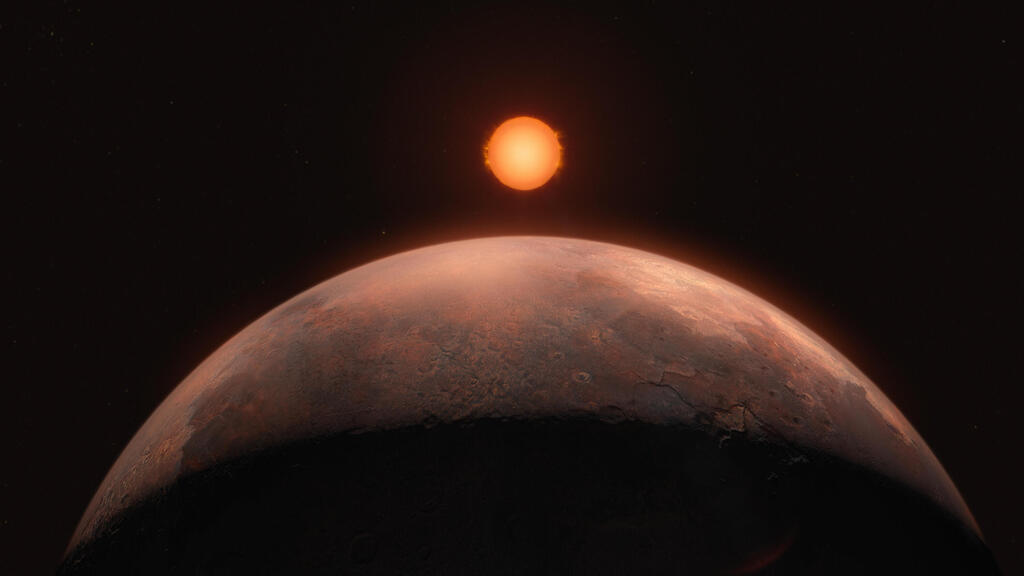Getting your Trinity Audio player ready...
Our sun is part of a cosmic minority of single stars. Most stars in the universe form part of a binary system, where two stars orbit each other, while others exist in more complex systems with three stars or more.
The closest solar system to us, Alpha Centauri, located less than 4.5 light-years away, is a triple system consisting of two stars similar in size to our Sun and a smaller star orbiting them. In recent years, several planets have been discovered around the smaller star, Proxima Centauri, sparking considerable interest due to their proximity.
Simulation of the Barnard b planet
(Video: European Space Agency)
In contrast, solitary stars like our Sun are relatively rare in the cosmos. The nearest solitary star to us is Barnard's Star, situated less than six light-years away. Despite its proximity, it cannot be seen with the naked eye because it is a red dwarf—small and relatively dim.
In recent years, researchers have extended their planet search to include planets around red dwarfs, making Barnard's Star a particularly promising target, as its proximity allows for extensive research through various means.
Six years ago, a team of scientists, including researchers from Israel, reported indirect evidence of a planet orbiting Barnard's Star. However, subsequent years of extensive searches failed to confirm the planet's existence — until now.
An international team of researchers recently reported in an article in the journal Astronomy & Astrophysics that they successfully verified the existence of a planet orbiting Barnard's Star, using observations and measurements from the VLT telescope of the European Southern Observatory (ESO) in Chile.
The planet, designated Barnard b, is one of the smallest exoplanets discovered to date, with a mass approximately one-third that of Earth. It orbits its star at a very close distance—only a few million kilometers away—completing an orbit in 3.15 Earth days. Despite Barnard's Star being approximately 2,500 degrees cooler than our Sun, the planet's surface temperature, due to its proximity, is around 125 degrees Celsius—too hot to sustain liquid water on its surface, a condition necessary for life as we know it.
Barnard was discovered using measurements from an instrument called ESPRESSO—a spectrograph specifically designed to search for planets in distant solar systems by accurately measuring minute changes in a star's rotation.
ESPRESSO allows scientists to detect variations in the star's light emission, indicating movements toward or away from us. From these measurements, scientists can determine whether other bodies in the system are affecting the star's center of gravity. By analyzing the gravitational patterns, such as the frequency of changes, they can determine the planet's orbital period, mass, and other characteristics.
Searching for neighbors
The researchers compared the measurements obtained using ESPRESSO with data from three other ESO instruments, each possessing slightly different characteristics. The research paper summarizes five years of measurements and data analysis.
“Even if it took a long time, we were always confident that we could find something,” said the head of the research team and lead author of the paper, Juan González Hernández, from the Instituto de Astrofísica de Canarias in Spain.
However, it is important to note that despite the high confidence presented by the researchers, based on an in-depth analysis of extensive data, there has not been a direct observation of the planet—something that seems almost impossible given the small size of the object and its close orbit around its star.
Previous research suggested indirect evidence of an entirely different planet orbiting Barnard’s Star, one with a mass three times that of Earth, completing its orbit every 233 days. The new study found no evidence for such a planet, although the researchers point to signs of three additional planets in the system, possibly even more, some potentially smaller than Earth.
“We now need to continue observing this star to confirm the other candidate signals,” said Alejandro Suárez Mascareño, a member of the research team at the Instituto de Astrofísica de Canarias and co-author of the study. "But the discovery of this planet, along with other previous discoveries such as Proxima b and d, shows that our cosmic backyard is full of low-mass planets.
Get the Ynetnews app on your smartphone:





